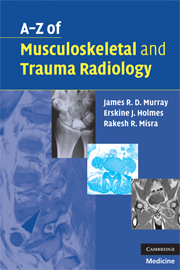Book contents
- Frontmatter
- Contents
- Acknowledgements
- Preface
- List of abbreviations
- Section I Musculoskeletal radiology
- Achilles tendonopathy/rupture
- Aneurysmal bone cysts
- Ankylosing spondylitis
- Avascular necrosis – osteonecrosis
- Femoral-head osteonecrosis
- Kienböck's disease
- Back pain – including spondylolisthesis/spondylolysis
- Bone cysts
- Bone infarcts (medullary)
- Charcot joint (neuropathic joint)
- Complex regional-pain syndrome
- Crystal deposition disorders
- Developmental dysplasia of the hip (DDH)
- Discitis and vertebral osteomyelitis
- Disc prolapse – PID – ‘slipped discs’ and sciatica
- Diffuse idiopathic skeletal hyperostosis (DISH)
- Dysplasia – developmental disorders
- Enthesopathy
- Gout
- Haemophilia
- Hyperparathyroidism
- Hypertrophic pulmonary osteoarthropathy
- Irritable hip/transient synovitis
- Juvenile idiopathic arthritis
- Langerhans-cell histiocytosis
- Lymphoma of bone
- Metastases to bone
- Multiple myeloma
- Myositis ossificans
- Non-accidental injury
- Osteoarthrosis – osteoarthritis
- Osteochondroses
- Osteomyelitis (acute)
- Osteoporosis
- Paget's disease
- Perthes disease
- Pigmented villonodular synovitis (PVNS)
- Psoriatic arthropathy
- Renal osteodystrophy (including osteomalacia)
- Rheumatoid arthritis
- Rickets
- Rotator-cuff disease
- Scoliosis
- Scheuermann's disease
- Septic arthritis – native and prosthetic joints
- Sickle-cell anaemia
- Slipped upper femoral epiphysis (SUFE)
- Tendinopathy – tendonitis
- Tuberculosis
- Tumours of bone (benign and malignant)
- Section II Trauma radiology
Renal osteodystrophy (including osteomalacia)
from Section I - Musculoskeletal radiology
Published online by Cambridge University Press: 22 August 2009
- Frontmatter
- Contents
- Acknowledgements
- Preface
- List of abbreviations
- Section I Musculoskeletal radiology
- Achilles tendonopathy/rupture
- Aneurysmal bone cysts
- Ankylosing spondylitis
- Avascular necrosis – osteonecrosis
- Femoral-head osteonecrosis
- Kienböck's disease
- Back pain – including spondylolisthesis/spondylolysis
- Bone cysts
- Bone infarcts (medullary)
- Charcot joint (neuropathic joint)
- Complex regional-pain syndrome
- Crystal deposition disorders
- Developmental dysplasia of the hip (DDH)
- Discitis and vertebral osteomyelitis
- Disc prolapse – PID – ‘slipped discs’ and sciatica
- Diffuse idiopathic skeletal hyperostosis (DISH)
- Dysplasia – developmental disorders
- Enthesopathy
- Gout
- Haemophilia
- Hyperparathyroidism
- Hypertrophic pulmonary osteoarthropathy
- Irritable hip/transient synovitis
- Juvenile idiopathic arthritis
- Langerhans-cell histiocytosis
- Lymphoma of bone
- Metastases to bone
- Multiple myeloma
- Myositis ossificans
- Non-accidental injury
- Osteoarthrosis – osteoarthritis
- Osteochondroses
- Osteomyelitis (acute)
- Osteoporosis
- Paget's disease
- Perthes disease
- Pigmented villonodular synovitis (PVNS)
- Psoriatic arthropathy
- Renal osteodystrophy (including osteomalacia)
- Rheumatoid arthritis
- Rickets
- Rotator-cuff disease
- Scoliosis
- Scheuermann's disease
- Septic arthritis – native and prosthetic joints
- Sickle-cell anaemia
- Slipped upper femoral epiphysis (SUFE)
- Tendinopathy – tendonitis
- Tuberculosis
- Tumours of bone (benign and malignant)
- Section II Trauma radiology
Summary
Characteristics
Renal osteodystrophy is a global term used to describe bone and joint changes secondary to chronic renal failure.
Osteomalacia is characterised by incomplete mineralisation of the normal bone tissue.
Abnormal phosphate retention in renal osteodystrophy leads to hypocalcaemia with resulting secondary hyperparathyroidism.
Combined features of osteomalacia and secondary hyperparathyroidism are seen.
Clinical features
Osteomalacia tends to present with non-specific bone pain and muscle weakness. Fractures are common especially in the more severely affected patients. Typical sites include femoral neck, pubic rami and vertebral bodies.
Renal osteodystrophy can also present with rather non-specific features. Weakness and bone pain are common. Fractures are the most frequent complication.
Radiological features
Osteomalacia – osteopenia may be the only sign. Coarsened trabeculae with a decrease in number and size. Bone deformity from softening. Pseudofractures = Looser zones (lucent lines at right angles to bone margin, especially in the scapula and femoral neck) and overt fractures may be evident.
Renal osteodystrophy is characterised by bony resorption, soft tissue calcification and osteopenia. Osteosclerosis of the vertebral endplates leads to the classical ‘rugger-jersey spine’. Pathological fractures can also occur through brown tumours and amyloid deposits. Sub-periosteal bone resorption should be sought in the distal phalangeal tufts and along the radial borders of the middle phalanges. Skull radiology may show a ‘salt and pepper’ appearance secondary to trabecular resorption.
Bone scans are useful in showing ‘hot spots’ secondary to subtle fractures. Diffuse uptake (‘superscan’) is seen with renal osteodystrophy and can be confused with widespread metastatic disease.
Management
Treatment is often directed towards the underlying cause of the disease.
Medical management involves calcium and phosphate control.
[…]
- Type
- Chapter
- Information
- A-Z of Musculoskeletal and Trauma Radiology , pp. 122 - 123Publisher: Cambridge University PressPrint publication year: 2008



